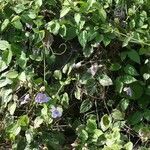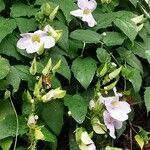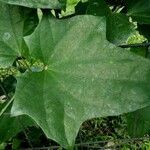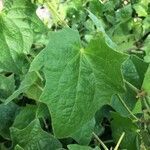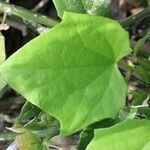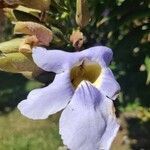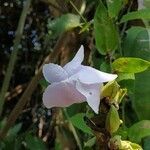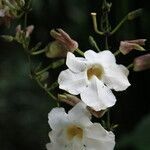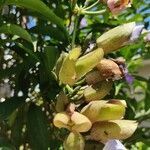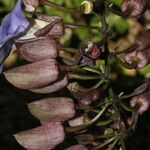Vines to 10 m or longer, woody. Stems 4-angled, sulcate, pubescent. Petiole 1-7 cm, grooved, pubescent; leaf blade ovate to triangular-ovate, 5-10 × 4-8 cm, papery, both surfaces pubescent, palmately 3-7-veined, base subcordate to truncate, margin undulate, irregularly angular on basal half, or rarely entire, apex acuminate to acute. Flowers solitary, paired in leaf axils, or arranged in terminal racemes with 2-4 flowers per node; peduncle 4-7 cm, sulcate, pubescent; rachis pubescent with large cyathiform glands; apical inflorescence bracts subulate to linear-subulate, 2-6 × 1-1.5 mm, pubescent; bracteoles oblong to ovate, 2.5-4 × 1.5-2.2 cm, both surfaces pubescent, 5-7-veined, base truncate, margin entire or ciliate, apex acute with a short mucro. Calyx ca. 2 mm, annular, unlobed, densely pubescent. Corolla bluish with a yellowish throat, 4-6 cm, outside glabrous; tube basally cylindric and ca. 3 mm wide for ca. 7 mm then gradually widened to ca. 5 cm at throat; limb subactinomorphic; lobes ovate, ca. 3 × 2.5 cm. Staminal filaments 7-9 mm; anther thecae pubescent, basally appendaged. Style glabrous; stigma with 2 subequal lobes. Capsule 1.2-1.5 cm, pubescent, basal part 1.3-1.8 cm in diam., beak ca. 2.5 cm. Seeds ovate in outline, compressed, verrucose. Fl. Aug-Jan, fr. Nov-Mar. 2n = 56.
Suffrutescent climbing or twining vine; tips of stem quadrangular, young stems strigose. Leaves ovate to ovate hastate, 8-16 cm long, 3.0-13.5 cm wide, acuminate at the tip, chartaceous, scabrous on both the surfaces, hastate or rounded at the base, often coarsely toothed or lobed below the middle; petioles 1-5 cm long. Inflorescences in axillary or terminal racemes, the bracts irregularly oblong, to 3.5 cm long and 2 cm wide, acuminate, striate nerved, covered with minute dark dots. Flowers with the calyx purplish; corolla lavender with yellow center, campanulate, the tube 3.0-4.5 cm long, lobes 3-4 cm long; base of the exterior anther cells of the posterior stamens with rigid sharp curved spurs to 3 mm long, the anterior stamens with only one spur on each. Capsule globular, 16 mm in diameter, tipped with a stout, flattened beak about 2 cm long.
A woody vine. The stems can be 4 cm across. The young stems are hairy. It has underground runners. The leaves have leaf stalks. The leaf blades are oval and 1-2 times as long as wide. They usually have lobes spread out like fingers on a hand. The flowering clusters can be in the axils of leaves or at the ends of branches. They hang in groups 2 m long. They are light blue.
